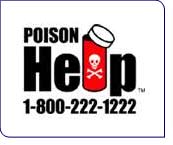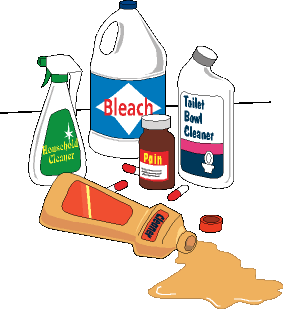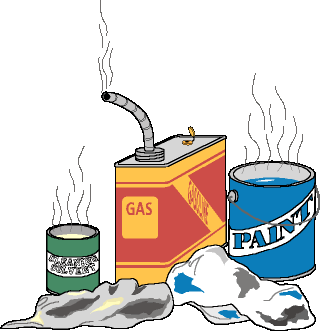

CALL for guidance

Use IPECAC Syrup only as directed by Poison Control
|
CALL for guidance |
Use IPECAC Syrup only as directed by Poison Control |
A poison - also called a toxin - is a substance which, if taken into the body in sufficient quantity, may cause temporary or permanent damage.
Poisons can be swallowed, absorbed through the skin, inhaled, splashed into the eyes, or injected. Once in the body, they may enter the bloodstream and be carried swiftly to all organs and tissues. Recognition features vary with the poison - they may develop quickly or over a number of days.
See the individual tips for recognition features and treatment of specific poisons.
 |
 |
Introduction
Chemicals that are swallowed may harm the digestive tract, or cause more widespread damage if they enter the bloodstream and are transported to other parts of the body.
Hazardous chemicals include common household substances. For example, bleach, dishwasher detergent, and paint stripper are poisonous or corrosive if swallowed. Drugs, whether they are prescribed or bought over the counter, are also potentially harmful if they are taken in overdose. The effects of poisoning depend on the substance that has been swallowed.
Depends on the poison, but there may be:
Your goal:
If the person is conscious:
If the person becomes unconscious:
DO NOT induce vomiting
Disclaimer: This information is not intended be a substitute for professional medical advice. It is provided for educational purposes only. You assume full responsibility for how you choose to use this information.
Foxglove |
 |
Amanita verna |
Introduction
Many young children eat plant leaves or brightly coloured berries, but serious poisoning as a result rarely occurs.
However, ingesting even small amounts of foxglove or wild arum can cause nausea, vomiting, and stomach cramps; and large amounts are potentially fatal. Seizures may occur after ingesting laburnum seeds.
Serious poisoning as a result of eating mushrooms is also rare. Mushrooms found in the garden may cause nausea, vomiting, and occasionally, hallucinations. Death cap mushrooms cause vomiting and severe watery diarrhoea between 6 and 12 hours after ingestion and can be fatal.
There may be:
Your goal :
If the person is conscious:
If the person becomes unconscious:
DO NOT induce vomiting
Disclaimer: This information is not intended be a substitute for professional medical advice. It is provided for educational purposes only. You assume full responsibility for how you choose to use this information.

Poisoning can result from an overdose of either prescribed drugs or drugs that are bought over the counter. It can also be caused by drug abuse or drug interaction.
The effects vary depending on the type of drug and how it is taken (see table below). When you call the emergency services, give as much information as possible. While waiting for help to arrive, look for containers that might help you to identify the drug.
Category |
Drug |
Effects of poisoning |
Painkillers |
Aspirin (swallowed) |
|
|
Paracetamol (swallowed) |
|
Nervous system depressants and tranquillisers |
Barbiturates and benzodiazepines (swallowed) |
|
Stimulants and hallucinogens |
Amphetamines (including Ectasy) and LSD (swallowed); cocaine (inhaled) |
|
Narcotics |
Morphine, heroin (commonly injected) |
|
Solvents |
Glue, lighter fuel (inhaled) |
|
Treatment
Your goal:
If the person is conscious:
If the perosn becomes unconscious:
DO NOT induce vomiting
Disclaimer: This information is not intended be a substitute for professional medical advice. It is provided for educational purposes only. You assume full responsibility for how you choose to use this information.
Foods that easily spoil |
|
E-Coli |
Introduction
Food poisoning is usually caused by consuming food or drink that is contaminated with bacteria or viruses. Some food poisoning is caused by poisons (toxins) from bacteria already in the food. The salmonella or E. coli group of bacteria, which are found mainly in meat, are common causes of food poisoning.
Symptoms may develop rapidly (within hours), or they may not occur until a day or so after eating contaminated food.
Toxic food poisoning is frequently caused by poisons produced by the staphylococcus group of bacteria. Symptoms usually develop rapidly, possibly with 2-6 hours of eating the affected food.
One of the dangers of food poisoning is loss of body fluids. The dehydration that results from this fluid loss can be serious if the fluids are not replaced quickly enough. Dehydration is especially serious in the very young and the very old, and, in some cases, treatment may be required in hospital.
There may be:
If the person's condition worsens:
Disclaimer: This information is not intended be a substitute for professional medical advice. It is provided for educational purposes only. You assume full responsibility for how you choose to use this information.

Alcohol (chemical name, ethanol) is a drug that depresses the activity of the central nervous system - in particular, the brain.
Prolonged or excessive intake can severely impair all physical and mental functions, and the person may sink into deep unconsciousness.
There are several risks to the person from alcohol poisoning:
There may be:
In the later stages of unconsciousness:
Your goal:
If the person is conscious:
If the person becomes unconscious:
DO NOT induce vomiting
Disclaimer: This information is not intended be a substitute for professional medical advice. It is provided for educational purposes only. You assume full responsibility for how you choose to use this information.
Lead Poisoning

If you have young children, it's important to find out whether there's any risk that they might be exposed to lead, especially if you live in an older home.
Long-term exposure to lead, a naturally occurring metal used in everything from construction materials to batteries, can cause serious health problems, particularly in young kids. Lead is toxic to everyone, but unborn babies and young children are at greatest risk for health problems from lead poisoning — their smaller, growing bodies make them more susceptible to absorbing and retaining lead.
Each year in the United States 310,000 1- to 5-year-old kids are found to have unsafe levels of lead in their blood, which can lead to a wide range of symptoms, from headaches and stomach pain to behavioral problems and anemia. Lead can also affect a child's developing brain.

The good news is that you can protect your family from lead poisoning. If your child is between 6 months and 3 years of age, talk to your doctor about potential lead sources in your house or anywhere your child spends long periods of time. And it's important for kids to get tested for lead exposure at age 1 and again at age 2, as many with lead poisoning don't show any symptoms.
Why Is Lead Harmful?
When the body is exposed to lead — by being inhaled, swallowed, or in a small number of cases, absorbed through the skin — it can act as a poison. Exposure to high levels of lead in a short period of time is called acute toxicity. Exposure to small amounts of lead over a long period of time is called chronic toxicity.
Lead is particularly dangerous because once it gets into a person's system, it is distributed throughout the body just like helpful minerals such as iron, calcium, and zinc. And lead can cause harm wherever it lands in the body. In the bloodstream, for example, it can damage red blood cells and limit their ability to carry oxygen to the organs and tissues that need it.
Most lead ends up in the bone, where it causes even more problems. Lead can interfere with the production of blood cells and the absorption of calcium that bones need to grow healthy and strong. Calcium is essential for strong bones and teeth, muscle contraction, and nerve and blood vessel function.
What Are the Effects of Long-Term Lead Poisoning?
Lead poisoning may lead to a variety of health problems in children, including:
How Does Lead Poisoning Occur?
Most commonly, young children get lead poisoning from lead-based paint, which was used in many U.S. homes until the late 1970s, when the dangers of lead became known and the government banned the manufacture of paint containing lead.
That's why kids who live in older homes are at a greater risk for lead poisoning. Also at risk are those who immigrate to the United States or are adopted from a foreign country that doesn't regulate the use of lead.
Lead is also found in other environmental areas, including:
How Do I Know if My Child Has Lead Poisoning?
Many kids with lead poisoning don't show any signs of being sick, so it's important to eliminate lead risks at home and to have your young child tested for lead exposure.
When kids do develop symptoms of lead poisoning, they usually appear as:
These symptoms may also indicate a wide variety of other illnesses, so if your child has any of them, talk to your doctor. A blood test may be necessary to look for lead poisoning or other health problems.
How Can I Protect My Child?
You can protect your child from lead poisoning by ensuring that your home is lead-free — ask your local health department about having your home evaluated for lead sources. And have your child tested for lead exposure, particularly if he or she is between 6 months and 3 years old. Kids this age spend a lot of time on the floor and trying to put things in their mouths.
These tips can help you reduce the risk of lead exposure:
If you suspect that you might have lead-based paint on your walls, use a wet cloth to wipe windowsills and walls. Watch out for water damage that can make paint peel. Sanding or heating lead-based paint is a bad idea because these increase the risk that lead will be inhaled. If the paint doesn't have many chips, a new layer of paint, paneling, or drywall will probably reduce the risk. It's best to consult a professional, especially because other precautions may need to be taken to contain the lead in the paint.
How Is Lead Poisoning Treated?
Treatment for lead poisoning varies depending on how much lead is in the blood. Small amounts can often be treated rather easily; the most important part of therapy is reduction of lead exposure. Gradually, as the body naturally eliminates the lead, the level of lead in the blood will fall.
Kids with severe cases and extremely high lead levels in their blood will be hospitalized to receive a medication called a chelating agent, which chemically binds with lead, through an IV to make the lead weaker so the body can get rid of it naturally.
All siblings of a child found to have lead poisoning also should be tested. Doctors will report cases of lead poisoning to the public health department.
Disclaimer: This information is not intended be a substitute for professional medical advice. It is provided for educational purposes only. You assume full responsibility for how you choose to use this information.
Reviewed by: Kate M. Cronan, MD
Date reviewed: June 2006